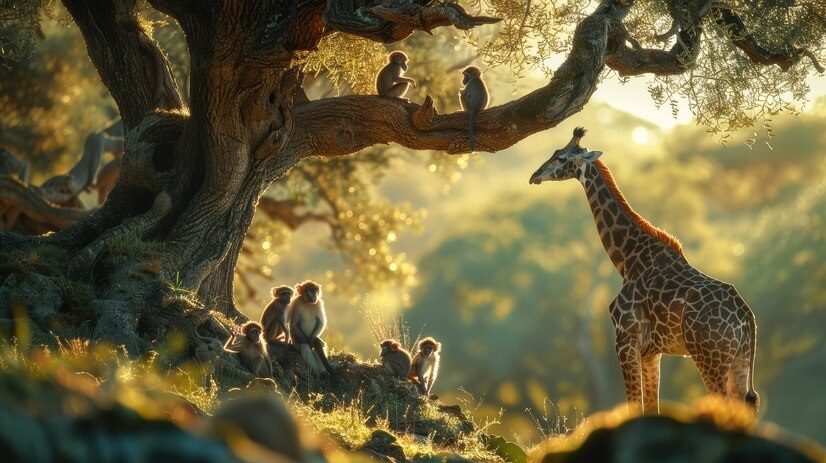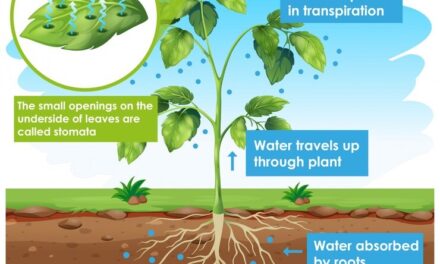Introduction to Adaptation
The natural world is a marvel of diversity, with living organisms thriving in a vast array of environments, from the scorching deserts to the frozen tundras. This remarkable adaptability is the result of a process called adaptation, where living things evolve specific characteristics and behaviors that allow them to survive and thrive in their surroundings.
Adaptation is the result of the evolutionary process, where species undergo gradual changes over generations in response to the challenges and opportunities presented by their environment. These adaptations can take many forms, from physical characteristics like specialized body structures to behavioral traits like migration patterns.
In this chapter, we will explore the fascinating world of adaptation, delving into the various components of the natural environment and how living organisms have evolved to exploit the resources and overcome the challenges they face.
The Natural Environment and Its Components
The natural environment can be broadly divided into two main categories: the biotic components and the abiotic components.
Biotic Components:
The biotic components of the environment refer to all the living organisms that inhabit a particular ecosystem. This includes:
- Producers: Organisms, such as plants, that are capable of producing their own food through the process of photosynthesis.
- Consumers: Organisms that consume other living things for food, including herbivores (primary consumers), carnivores (secondary and tertiary consumers), and omnivores.
- Decomposers: Organisms, such as bacteria and fungi, that break down and recycle the nutrients from dead organic matter.
- Microorganisms: Tiny, single-celled organisms like bacteria, viruses, and protists that play crucial roles in many ecological processes.
Interactions among Biotic Components:
The biotic components of an ecosystem are not isolated; they interact with one another in complex and interconnected ways. These interactions can take various forms:
- Predation: Where one organism (the predator) hunts and consumes another organism (the prey).
- Competition: When organisms of the same or different species compete for limited resources, such as food, water, or living space.
- Symbiosis: Relationships between organisms where one or both species benefit, such as mutualism, commensalism, and parasitism.
Abiotic Components:
The abiotic components of the environment refer to the non-living factors that influence and shape the ecosystem. These include:
- Physical factors: Such as temperature, light, water, soil, and air.
- Chemical factors: Such as the availability of nutrients, pH levels, and the presence of pollutants.
Interactions between Biotic and Abiotic Components:
The biotic and abiotic components of an ecosystem are intrinsically linked, with each influencing and shaping the other. For example, the availability of water (an abiotic factor) can determine the types of plants and animals (biotic factors) that can thrive in a particular habitat.
Habitats and Ecosystems
A habitat is the specific environment where a living organism or community of organisms lives and interacts with the abiotic and biotic components around them. Habitats can be broadly classified into two main types: aquatic and terrestrial.
Aquatic Habitats:
Aquatic habitats are those that are dominated by water, and they can be further divided into:
- Marine habitats: Such as the open ocean, coral reefs, and coastal regions.
- Freshwater habitats: Such as rivers, lakes, ponds, and wetlands.
- Coastal habitats: Such as estuaries, mangrove swamps, and salt marshes.
Terrestrial Habitats:
Terrestrial habitats are those that are dominated by land, and they can be further divided into:
- Desert habitats: Characterized by low rainfall, high temperatures, and sparse vegetation.
- Grassland habitats: Dominated by grasses and other herbaceous plants, with few trees.
- Rainforest habitats: Characterized by dense, lush vegetation and high levels of biodiversity.
- Tundra and polar habitats: Characterized by low temperatures, permafrost, and a limited growing season.
- Mountain habitats: Characterized by changes in elevation, temperature, and precipitation with increasing altitude.
Adaptation and Its Types
Adaptation is the process by which living organisms evolve specific characteristics or behaviors that allow them to better survive and thrive in their environment. There are several different types of adaptation:
- Structural adaptation: Changes in the physical structure or morphology of an organism, such as the development of specialized body parts or organs.
- Behavioral adaptation: Changes in the way an organism behaves, such as migration patterns, foraging strategies, or defense mechanisms.
- Physiological adaptation: Changes in the internal processes or functions of an organism, such as the ability to regulate body temperature or conserve water.
Adaptations for Desert Regions
Deserts are characterized by low rainfall, high temperatures, and limited water availability. Living organisms in desert environments have evolved a variety of adaptations to cope with these challenging conditions.
Adaptations of Desert Plants:
– Succulent leaves and stems: Many desert plants, such as cacti and agave, have thick, fleshy leaves and stems that store water to help them survive during periods of drought.
– Reduced leaf surface area: Some desert plants have small, narrow leaves or spines instead of leaves to minimize water loss through transpiration.
– Deep or extensive root systems: Desert plants often have deep or widespread root systems that can access water sources deep underground.
– Dormancy during dry periods: Some desert plants can enter a state of dormancy, or “hibernation,” during the hottest and driest times of the year to conserve water and energy.
Adaptations of Desert Animals:
– Burrowing and seeking shade: Many desert animals, such as rodents and reptiles, spend the hottest parts of the day in underground burrows or shaded areas to avoid the intense heat.
– Water conservation: Desert animals have evolved ways to minimize water loss, such as the ability to concentrate their urine, reduce sweating, or obtain water from their food.
– Nocturnal activity: Many desert animals, including mammals and insects, are active at night when temperatures are cooler and water loss is reduced.
– Adaptations for mobility: Some desert animals, like camels and kangaroo rats, have specialized adaptations, such as wide feet or long legs, that allow them to move efficiently across the sandy terrain.
Adaptations for Water Habitats
Aquatic habitats, whether marine or freshwater, present their own unique challenges for living organisms, and they have evolved a variety of adaptations to thrive in these environments.
Adaptations of Aquatic Plants:
– Floating leaves and stems: Many aquatic plants, such as water lilies and duckweed, have leaves and stems that float on the water’s surface to maximize their exposure to sunlight.
– Submerged leaves and stems: Aquatic plants that are fully submerged often have thin, ribbon-like leaves and streamlined stems to reduce drag and facilitate movement in the water.
– Air-filled tissues: Some aquatic plants, like cattails and reeds, have hollow, air-filled stems and leaves that help them stay buoyant.
– Specialized reproductive structures: Aquatic plants may have flowers or reproductive structures that are adapted to disperse their seeds or spores through the water.
Adaptations of Aquatic Animals:
– Streamlined body shapes: Many aquatic animals, such as fish and marine mammals, have evolved streamlined body shapes and smooth skin to reduce drag and move efficiently through the water.
– Gills or other respiratory adaptations: Aquatic animals, like fish and amphibians, have specialized respiratory structures, such as gills or a combination of gills and lungs, to extract oxygen from the water.
– Buoyancy adaptations: Some aquatic animals, like jellyfish and sea turtles, have adaptations that help them maintain neutral buoyancy in the water, allowing them to conserve energy.
– Sensory adaptations: Aquatic animals often have specialized sensory organs, such as lateral lines in fish or echolocation in marine mammals, to detect prey, navigate, and avoid predators in the underwater environment.
Adaptations for Polar and Mountain Habitats
Polar and mountain habitats are characterized by low temperatures, high winds, and limited resources, and the organisms that thrive in these environments have evolved unique adaptations to cope with these challenging conditions.
Adaptations of Polar and Mountain Plants:
– Reduced size and growth habit: Many polar and mountain plants, such as dwarf shrubs and cushion plants, have a low, compact growth form to minimize exposure to harsh winds and conserve resources.
– Thick, waxy leaves: Polar and mountain plants often have leaves with a thick, waxy cuticle to reduce water loss and protect against freezing temperatures.
– Specialized root systems: The roots of polar and mountain plants may be shallow and widespread to access the limited soil resources, or they may be able to grow in rocky, nutrient-poor substrates.
– Adaptations for snow cover: Some plants, like the alpine snowbell, have evolved the ability to flower and grow beneath the snow, taking advantage of the insulating properties of the snow layer.
Adaptations of Polar and Mountain Animals:
– Insulation and fur/feather adaptations: Many polar and mountain animals, such as polar bears, reindeer, and mountain goats, have thick fur or feathers to conserve body heat and protect against the cold.
– Behavioral adaptations: Polar and mountain animals may exhibit behaviors like huddling, burrowing, or migrating to avoid the harshest environmental conditions.
– Physiological adaptations: Some animals, like the grizzly bear, can enter a state of torpor or hibernation during the winter months to conserve energy and resources.
– Specialized locomotion: Animals in polar and mountain habitats may have adaptations, such as large, padded feet or sharp hooves, that allow them to move efficiently over snow, ice, and rocky terrain.
Adaptations for Grassland Habitats
Grasslands are characterized by the dominance of grasses and other herbaceous plants, with relatively few trees or shrubs. The organisms that thrive in these environments have developed adaptations to cope with the unique challenges of the grassland habitat.
Adaptations of Grassland Plants:
– Extensive root systems: Grassland plants often have deep, extensive root systems that can access water and nutrients deep in the soil, allowing them to survive periods of drought.
– Leaf and stem adaptations: Grasses and other grassland plants may have narrow, elongated leaves and flexible stems that can bend and sway in the wind without breaking.
– Rapid growth and reproduction: Many grassland plants are adapted to take advantage of the short growing season, rapidly growing and reproducing before the onset of harsher environmental conditions.
– Tolerance to grazing: Some grassland plants have evolved defenses, such as tough leaves or thorns, to protect themselves from being consumed by herbivores.
Adaptations of Grassland Animals:
– Mobility and herding behavior: Many grassland animals, such as gazelles and bison, are highly mobile and often live in herds, which can provide protection from predators and improve access to resources.
– Adaptations for grazing: Grassland herbivores, like deer and antelope, have specialized dentition and digestive systems that allow them to efficiently extract nutrients from the grasses and other vegetation.
– Burrowing adaptations: Some grassland animals, like prairie dogs and ground squirrels, have evolved the ability to burrow underground, providing shelter from the elements and predators.
– Camouflage and warning coloration: Grassland animals may have adaptations like cryptic coloration or warning patterns that help them blend in with their surroundings or deter predators.
Investigative Experiments and Amazing Facts
- Experiment: Observing Adaptations in Aquatic Plants
Materials: Aquarium or clear container, various aquatic plants (e.g., water lily, duckweed, elodea)
Procedure:
– Set up the aquarium or container with water and carefully add the aquatic plants.
– Observe the plants over time, noting their growth patterns, leaf and stem structures, and any other adaptations.
Amazing Fact: The giant water lily (Victoria amazonica) has leaves that can grow up to 3 meters (10 feet) in diameter and support the weight of a small child.
- Experiment: Simulating Desert Adaptations
Materials: Potting soil, succulent plants (e.g., cactus, aloe vera), water, heat lamp
Procedure:
– Plant the succulents in the potting soil and place them under the heat lamp to simulate desert conditions.
– Observe the plants over time, noting how they conserve water and respond to the heat.
– Experiment with different watering regimes to see how the plants adapt.
Amazing Fact: The saguaro cactus, native to the Sonoran Desert, can grow up to 15 meters (50 feet) tall and live for over 200 years.
- Experiment: Modeling Polar Adaptations
Materials: Insulation materials (e.g., cotton, foam, feathers), ice cubes, thermometer
Procedure:
– Create a model “animal” using the insulation materials, then place it on the ice cubes.
– Measure the temperature inside the model and compare it to the ambient temperature.
– Experiment with different insulation materials and thicknesses to see how they affect heat retention.
Amazing Fact: The Arctic fox has a specialized coat that changes color from white in the winter to brown in the summer, providing camouflage in both seasons.
- Experiment: Observing Grassland Adaptations
Materials: Grass samples, soil samples, hand lens
Procedure:
– Collect samples of grasses and soil from a local grassland or park.
– Observe the grass samples, noting the structure of the leaves, stems, and root systems.
– Examine the soil samples to understand the nutrient and moisture content of the grassland habitat.
Amazing Fact: The root systems of some grassland plants can extend up to 5 meters (16 feet) deep into the soil, allowing them to access water and nutrients during periods of drought.
- Experiment: Investigating Camouflage in Grassland Animals
Materials: Camouflage clothing, open grassy area
Procedure:
– Dress in camouflage clothing and have a friend or classmate try to spot you in the grassy area.
– Experiment with different positions and movements to see how effective the camouflage is.
– Discuss how this relates to the adaptation of grassland animals for concealment and survival.
Amazing Fact: The pronghorn antelope, a grassland animal, can run at speeds of up to 88 km/h (55 mph), making it one of the fastest land animals in North America.
These experiments and amazing facts help to illustrate the diverse and fascinating ways in which living organisms have adapted to thrive in their respective environments. By actively engaging with these hands-on activities, students can deepen their understanding of the underlying principles and adaptations that enable organisms to survive and flourish in the natural world.
Conclusion
In this chapter, we have explored the incredible diversity of the natural world and the remarkable adaptations that allow living organisms to thrive in a wide range of environments, from the scorching deserts to the frozen tundras. By understanding the key components of the natural environment, including the biotic and abiotic factors, we have gained a deeper appreciation for the complex and interconnected relationships that shape the ecosystems in which we live.
Through the examination of specific adaptations, we have seen how living things have evolved specialized structures, behaviors, and physiological processes to overcome the challenges posed by their environments. From the water-conserving adaptations of desert plants and animals to the insulating features of polar and mountain dwellers, these adaptations are a testament to the remarkable resilience and ingenuity of life.
As we continue to explore the natural world and the forces that drive evolution, we will undoubtedly uncover even more fascinating insights into the ways in which living things have adapted to their surroundings. By fostering a deeper understanding and appreciation for these adaptations, we can not only marvel at the wonders of the natural world but also apply these principles to the development of innovative technologies and the betterment of human life.
In the end, the study of adaptation reminds us that we are not separate from the natural world, but rather an integral part of it. By understanding and respecting the delicate balance of the ecosystems that sustain us, we can work towards a more sustainable future, where the diversity of life on our planet can continue to thrive and adapt for generations to come.
This worksheet covers the following topics:-
Introduction
Adaptation, environment, ecology,
Biotic, abiotic
Natural environment, human-made environment,
Biotic Components and their Interactions,
Producers, Consumers,
Primary consumers,
Decomposers, Microorganisms, recycles the nutrients,
Interactions among biotic components,
Abiotic Components and their Interactions with Biotic Components
Habitat and types of habitat,
Aquatic habitat- Marine, Freshwater, Coastal, Estuaries,
Terrestrial Habitats- Desert habitat, Grassland habitat, Rainforest habitat,
Tundra and Polar habitat, Mountain habitat,
Adaptation and its types,
Adaptation for desert regions
Adaptations of plants in desert habitat and their features, succulent,
Adaptations of animals in desert habitat and their features
Adaptation for water habitats
Adaptations of plants in water habitat and their features,
Adaptations of animals in water habitat and their features
Adaptation for Polar and mountain habitat
Adaptations of plants in Polar and mountain habitat; and their features,
Adaptations of animals in Polar and mountain habitat; and their features, hibernation,
Adaptation for grassland habitats
Adaptations of plants in grassland habitats and their features,
Adaptations of animals in grassland habitats and their features
Image Courtesy- Freepik.com

















